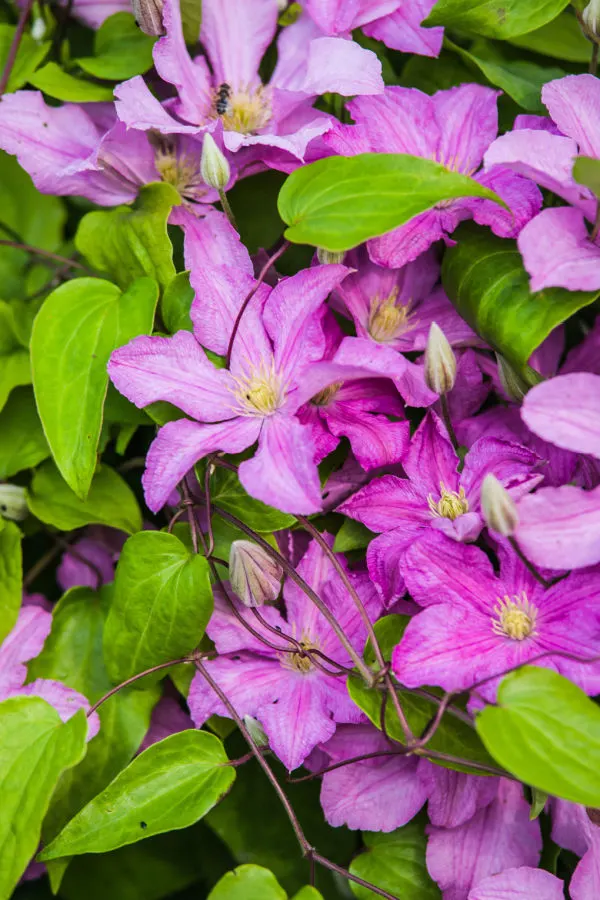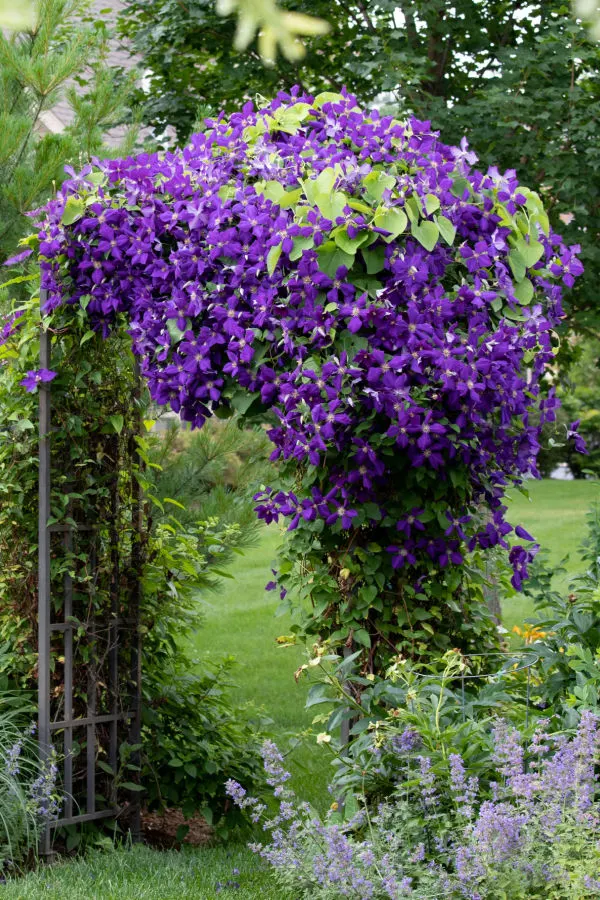Want to get your clematis to flower more than ever and even bloom again this summer?
It is hard to deny the incredible beauty of clematis when in full bloom. Perfect for fences, walls, light posts, arbors or anywhere it can climb or trail, this climbing perennial can fill a space with sensational color and a sweet floral fragrance that has a uniqueness all to its own.
But for many gardeners, the beauty never seems to last long enough through the growing season. Most herbaceous clematis perennials are spring bloomers. Although they are quite stunning for the two to three weeks while they are flowering, the plants just never look quite as pretty when only covered in foliage for the rest of the summer.

It’s certainly not that the shiny leaves don’t add beauty and interest. To be sure, even when clematis is not blooming the foliage is still quite attractive. But let’s face it, when flowering, this perennial takes its beauty to a whole new level!
But here is the good news – you don’t have to wait until next spring to have your clematis flower again. In fact, depending on where you live, with just a little bit of extra care, you can usually get herbaceous clematis to bloom not just once more – but two, three or even four more times in a single season!
How To Make Clematis Bloom Again & Again
When it comes to clematis, there are three critical needs that need to be met to have the plant produce additional bloom sets. All three are individually and equally important. Unfortunately, if just one is lacking, it is highly likely the plant will not re-bloom – or – even if it does, do so without much fanfare.
With that in mind, here are the three simple secrets that can help your clematis to flower over and over again this summer, letting you enjoy those blooms more than ever!
#1) Deadheading & Pruning – How To Get Clematis To Bloom Again
Deadheading is the practice of removing spent or fading blooms from a plant to help it bloom again. As blooms begin to die off, they continue to consume energy from the plant. And the longer they remain, the more energy they drain.

For many annual flowers, deadheading can help produce new blooms in mere days. But in the case of a clematis plant, deadheading helps the plant conserve energy to store and use for an entirely new flush of blooms about four to five weeks later. See: How To Deadhead Annual & Perennial Flowers
As soon as you notice blooms beginning to fade, remove them. A good pair of hand pruners or garden scissors will make quick work of the chore.
In addition to deadheading, a light pruning or cut back after your clematis blooms can also help it rejuvenate quickly. After your clematis stops blooming, prune stems back about 8 to 12 inches to the last healthy node.
This will force new growth and new buds, and have your plant on the path to re-blooming in no time at all. This can be done each time your clematis finishes blooming during the season to attempt to force another bloom.
Fertilizing – How To Get Clematis To Bloom More
Clematis plants use up a lot of available nutrients to bloom. And even though you help it to conserve energy by removing old blooms, the plant still needs to have its supply of energy refueled in order to bloom again.

The best way to refuel clematis is with fertilizer. But what you fertilize with is extremely important. Avoid fertilizers that have too much nitrogen. Although nitrogen helps power growth, too much of it will cause the plant to only concentrate on growing foliage – and not on producing new flowers.
Instead, look for fertilizers that contain more phosphorous and potassium as part of the Nitrogen-Phosphorous-Potassium (N-P-K) ratio. Nearly all fertilizers will list the N-P-K ratio on the bag. For clematis, look for N-P-K ratios that are in the 4-10-10 to 5-10-10 range. Product Affiliate Link : Lily Bulb & Bloom Food
The additional phosphorous will help give the plant energy for blooming. The higher potassium, meanwhile, will help the plant recover quicker and stay healthy. The lower nitrogen will still provide good growth and greenery, but not at the expense of future blooms.
As for how often to fertilize, it’s best to fertilize each time right as or immediately after the plant is finishing a bloom cycle. This is the optimum time for the plant to have additional energy to recover and store up for more blooming. Simply follow the recommended application rate on your fertilizer container for proper feeding.
#3) Watering – How To Get Clematis To Bloom Again
In addition to failing to deadhead and fertilize clematis as they finish blooming, another big reason clematis fail to bloom again is due to a lack of water.

Water is an extremely important factor in helping clematis to bloom. Clematis need moisture in the soil to help keep their roots properly hydrated. Without enough moisture to soak in, the roots shrivel. When this happens, it makes it nearly impossible for the plant to absorb additional nutrients. And without additional nutrients, clematis will struggle to create new blooms.
In the early spring, cooler weather and more frequent rains provide plenty of moisture for clematis to produce its bloom set. But once spring turns to summer, the temperatures turn much warmer. And even worse, the rains often come less frequently as well.
How much water is enough water for clematis? For best results, make sure your plants are getting at least one inch of water per week through the summer. If your clematis isn’t getting that through rain, you need to be supplying it by watering. Without it, the plant simply wont bloom again.
Proper watering is especially critical right as clematis begins to stop blooming. Good moisture at this point helps the plant heal and recharge quicker than ever. That, in turn, allows it to absorb post-flowering fertilizing better than ever.
Here is to getting more blooms and flowers from your clematis this year than ever!
Follow Our Facebook Page For Great Gardening Tips And Advice! This Is My Garden Facebook Page
This Is My Garden is a garden website created by gardeners, for gardeners. Jim and Mary Competti have been writing gardening, DIY and recipe articles and books and speaking for over 15 years from their 46 acre Ohio farm. They publish three articles every week, 52 weeks a year. Sign up today to follow via email, or follow along!

